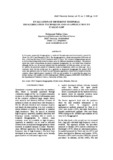| dc.contributor.author | Islam, Mohammad Rafiqul | |
| dc.date.accessioned | 2010-10-12T05:33:19Z | |
| dc.date.available | 2010-10-12T05:33:19Z | |
| dc.date.issued | 2009 | |
| dc.identifier.uri | http://hdl.handle.net/10361/460 | |
| dc.description.abstract | In this paper temporally disaggregation is conducted through regression-based models, namely by Chow-Lin (1971) and Fernandez (1981). The disaggregation is carried out using four GDP series of Italy, collecting data from ISTAT (Statistical office of Italy). We evaluated disaggregating capacity as well as forecasting ability about the future series by different simulation techniques. The analysis shows that Chow-Lin maximum likelihood estimation disaggregates the GDP better than Famandez although, for the case of seasonal adjusted data the performance of both procedure are very close. In contrast, the prediction equality of Femandez seems to outperform Chow-Lin (MaxLog). This a scholastic work, but the results may be a guideline to temporally disaggregate the annual GDP series into quarterly series by Chow-Lin and Femandez approaches, which will be beneficial for the countries where high frequency (quarterly) GDP are not available. It is noted that the paper was written during a two months research training under EMMA program (20/08/2009-20/10/2009) at the department of statistical sciences, university of Padua, Italy. | en_US |
| dc.language.iso | en | en_US |
| dc.publisher | BRAC University | en_US |
| dc.relation.ispartofseries | BRAC University Journal, BRAC University;Vol.6, No.2,pp. 21-32 | |
| dc.subject | GDP | en_US |
| dc.subject | Temporal disaggregation | en_US |
| dc.subject | Related series | en_US |
| dc.subject | Estimates | en_US |
| dc.subject | Forecast | en_US |
| dc.title | Evaluation of different temporal disaggregation techniques and an application to Italian GDP | en_US |
| dc.type | Article | en_US |

